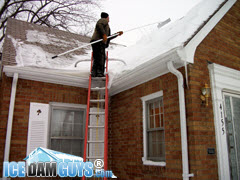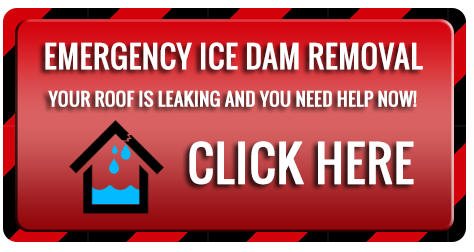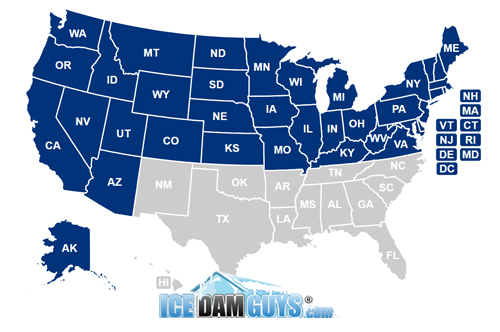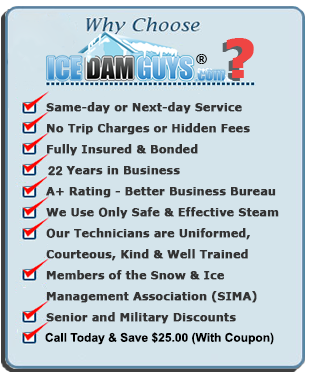Ice Dam Removal/Prevention Tools & Products: The Good, the Bad, and the Ugly
People have come up with various and sundry tools, products, and methods to to try to deal with ice dams – removing them or preventing them.
Some of those ice dam removal and prevention products work well. Others do not, and are a waste of time and a waste of money. A few may even put your roof or the rest of your home at risk.
We’ve put together this resource to help you make good decisions the next time there’s a five-inch block of ice and a mountain of snow sitting on your roof.
The Bad and the Ugly
None of these problems will help you overcome your ice dam problem. It doesn’t matter which company manufactures them. It doesn’t matter how cleverly you employ them. They will never give you the results that you want.
Heat Cables
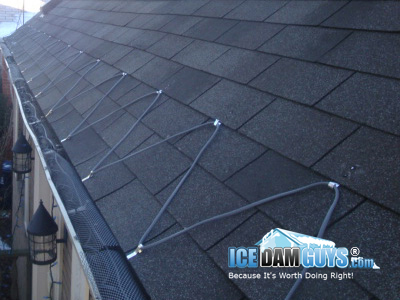
Heat cable goes by many names. You might also hear it called “heat tape” or “heat wire.” Lately, some enterprising individuals are even expanding these cables to create “snow melt mats.”
The basic idea is that you’re going to lay down a bunch of hot cables or long mats along your roof to melt ice and snow, especially around your roof edges and overhangs. Unfortunately, these cables can never really get hot enough to do very much good. If they could get that hot no lawyer in the land would allow them to be sold, because they’d be a fire hazard.
Furthermore, if you’ve been paying attention at all you already know that hot roofs are the #1 culprit when it comes to ice dam creation. If you don’t want your roof getting hot from the inside, then you don’t want it getting hot from the outside. Too often, we see people lay down tons of heat cable only to get ice dams anyway. That’s because it does indeed melt some of the snow. It just never makes it to the ground. It finds its way to another spot on the roof or hits the edge of your overhang where heat cables can’t go. The result is, of course, an ice dam.
So to recap, you’ve spent a ton of money on these cables. You’ve taken the time to put them on your roof. And now you’re going to have to pay for ice dam removal anyway. And make no mistake, heat cable is a pain to install. It’s even more of a pain than hanging your Christmas lights.
Gutter Guards (Even Heated Gutter Guards)
Gutter guards do nothing to prevent ice dams. Gutters do not cause ice dams. People who attempt to sell you a gutter guard system by telling you that you won’t get ice dams anymore either vastly misunderstand how ice dams form, or are trying to sell you a bill of goods.
Gutters just extend your home’s overhang, which can offer more space for an ice dam to form. However, ice dams form regardless of whether or not the gutters are full. Furthermore, ice dams can work their way under just about any gutter guard known to man. They will also add to the amount of money you’re going to have to spend on ice dam removal, because the gutter guard actually gets in our way.
Normally we have to fish big chunks of ice out of your gutter by hand. Gutter guards ensure that we cannot do that. Instead we must direct steam into the teeny tiny little opening that your guards have left us. Gutter ice removal is a painstaking process, it’s no fun, and it ultimately adds a bunch of hours to your bill.
Now you can even get heated gutter guards, which is even worse. Heated gutter guards: two bad ideas on steroids. The problem is exactly the same as the problem you’d see with heating cables. You’ll just melt more snow. It’ll refreeze as soon as it gets away from the gutter guard. Now you have an even more ferocious ice problem than you did before.
As we understand it, 90% of the gutter guards out there don’t even do a particularly good job of keeping the leaves out of your gutters during the warmer months. You might as well save your money.
Salt Pucks
Salt pucks (or salt bricks) are some of the most insipid things I’ve ever seen. In my experience they are the favorite “tools” of lazy or cheap husbands who want to reassure their anxious wives that they’ve “handled” the ice dam problem. The wife is usually the one who says, over and over again, “Honey, we need to call the ice dam removal professionals.” The husband says, “Don’t worry, honey, I went and threw some salt pucks out there!”
You will accomplish two things when you toss those things up there.
If you use the pucks, you’ll get a bunch of perfectly round holes—more like depressions—in the snow or ice around the puck. The ice dams will simply form around them or past them because they can never melt enough snow or ice to get the job done. You could probably use them to chill some beer, but that’s about it. If you use a salt brick then you don’t even get a nice spot for your beer. You just get perfectly rectangular but otherwise unimpressive impressions in the snow.
You’ll also manage to create perfectly geometrical patterns on your shingles that will show up in the summer when you discolor them. You’ll kill the grass and shrubbery around your home as the salty snow melts and splashes onto everything below.
That Panty Hose Trick That Never Seems to Die
This stupid idea just refuses to die. We’ve even seen it suggested on websites that really ought to know better, like This Old House.
The idea is you fill up a bunch of pantyhose with rock salt and then lay them in your gutters and on the edges of your roof to melt the ice. It’s cheap and fun for the whole family, right? Now you get all the problems that come along with salt pucks, as well as (as I’ve mentioned before) getting the fun-filled experience of making it look like Big Bird mistook your roof for a public bathroom as he migrated south for the winter.
Ice Melt or Heated Ice Melt
You use it on your driveway, why not your roof? Well, again, do you like the idea of damaging or discoloring your roof? Do you enjoy knowing that you will do both without actually managing to get rid of the ice dam that’s causing you so many problems?
Now someone has had the bright idea of selling “heated” ice melt systems. They look like big metal wands and hoses attached to big 5-gallon buckets of ice melt. There’s apparently some way to get the ice melt inside of the bucket hot.
Unfortunately, you’d need a lot more than 5 gallons to get that job done, even if the chemicals were a good idea. And if you already have an active leak then there’s a good chance that you’re about to spray a hot chemical mess into your home, which will never be the same.
Hot Water
Hot water can get the ice dam off your roof. Unfortunately, most of that water will usually end up inside of your house. Furthermore, unless your hot water heater is literally an industrial-capacity appliance then you will never generate enough hot water to get the job finished.
Hair Dryers
Those who are dead set against spending any money on ice dam removal will generally try to use a hair dryer to get the job done. You know, that thing which already has a big tag on it warning you not to use it in the bathtub.
Now think this through for a moment…you’re going to take that outside into the snow, which is a form of water. You’re going to run an extension cord back into the house, but the regular, indoor-rated cord is dangling as it connects to the extension cord. You’re going to blow and blow and blow, because of course hair dryers can’t generate much heat to begin with, or they’d burn your head every time you tried to use one. But perhaps you get a little traction and some water starts to melt.
You’re on a ladder. Where’s that water headed?
Oh yeah. Straight towards you. It will be like bringing your hair dryer into the shower with you.
There are easier ways to kill yourselves, folks.
Fire, Chainsaws, Hammers, Hatchets, and Chisels (Oh, my!)
At this point, some frustrated homeowners are ready to tap into their inner caveman. They’re going to go to war with this damn ice dam and they’re going to win if it’s the last thing they do.
First, let’s talk about blunt force, including chainsaws. Your shingles are actually incredibly easy to break in the winter time. Now you’re going to get up there with some sort of weapon or power tool and you’re going to go after that ice dam with all your might.
What are the chances, do you think, that you’re going to be so precise, so amazing, that you’ll never, ever hit a single shingle?
Pretty low. In fact, the chances are quite good that you’re going to hit a whole bunch of shingles. Damaging your roof. In winter. When roofers won’t work on it. And the chainsaw? Well, if you like the idea of cutting big holes or gashes into your roof or risking a collapse by actually cutting into the frame, go right ahead. That’s a real risk, and while it will certainly make your winter eventful it won’t do much to keep water out of your home.
And…do I even really have to talk about why fire is a bad idea? And yes, people try it. We’ve seen people coat their ice dams in gasoline and set them alight. Talk about desperation! These folks never really have a plan for how they’re going to get the fire to stop when the snow and ice is gone. Look, I know ice dams are frustrating, but burning down your house is counter-productive.
And Now, for the Good…
These products and tools will either help you prevent ice dams, stop ice dams, or minimize the damage that ice dams can cause in your home.
Ice and Water Shielding
If you are installing a new roof, then asking your roofer to install ice and water shielding on every available surface is a great idea. It will cost more but it will be worth it.
Ice and water shielding doesn’t prevent ice dams, but it does stop leaks. If you can keep the water from coming into your home, then you may not have to worry about removing the ice dam unless it grows large enough and heavy enough that the threat of a collapse becomes a very real concern.
You have some ice and water shielding on your home now—Minnesota code demands it. But it only runs from the drip edge of your overhang to about two feet past your first interior wall. I’m telling you that you want to wrap that puppy up like a baby in a warm blanket, putting as much as you can all over your roof without compromising your roof’s ability to ventilate itself.
Home Energy Audits
A home energy audit will tell you all of the things you need to fix to keep your roof from getting hot in the winter. (Actually, the auditor will talk about all the places you are “losing energy,” but it amounts to the same thing). As long as you invest the money and follow all of the suggestions you will drastically reduce your chances of getting ice dams.
Note that I said reduce, not eliminate, because there is just nothing that can be done about certain weather conditions. If temperatures are rising above freezing during the day and plunging again at night then ice dams could form, even if you do everything right. However, this is the step you must take if you want ice dams to become a rare occurrence instead of an annual event.
Shovels
Shovels cannot help with ice, but they will help you get some snow off your roof. I say this with a few caveats.
First, the shovel should be plastic if you want to avoid damaging your roof. Otherwise, you’re just taking the equivalent of a big metal chisel up there (and we’ve already seen why that is a bad plan).
Second, think twice before getting up there. We take shovels up there to remove as much snow as possible before we start steaming the ice away, but we’re trained, licensed, insured professionals. You could fall off your roof and hurt yourself. Any snow removal solution you exercise yourself should keep your feet firmly on the ground.
Obviously, this will not help you with an ice dam that has already formed. Ice is ice, and no shovel will remove it.
Snow Blowers
Again, we use them, especially to get snow off of delicate roof surfaces like skylights, solar panels, tile roofing or glass roofing. They’re perfectly effective and they’re nice because they don’t make any contact with the roof.
However, again, I’m going to tell you to stay off the roof if you can.
Roof Rakes
If there is one DIY product that I would recommend to homeowners, it would be the humble roof rake. However, I want to stress that this is a DIY ice dam prevention product, not a DIY removal product. Once the ice dam has formed, you need professional help.
Simply put, if you can get the snow off of your roof then there is nothing for either your hot roof or Mother Nature to melt. No melting snow means no re-freezing snow, which means no ice dams.
In practice it’s difficult to get all of the snow off of your roof. However, if you can get most of the snow then you drastically reduce your chances of needing ice dam removal services.
You should choose a plastic roof rake or one with small rollers on it, or a “snow slide.” You don’t want any metal edges attacking your shingles. The technique is simple. You stand on the ground and you slowly pull the snow off of your roof. Get as high as you can reach, but do not stand on a ladder. If you see three inches of snow or more on your roof, then you might want to get out there. If you see six inches of snow it’s definitely time to get out there. You don’t have to grab the roof rake every time you see flurries, but you don’t want to allow the snow to pile up out there, either.
Here’s a roof rake we use and recommend, and a snow slide we use and recommend.
Ice Dam Steamers
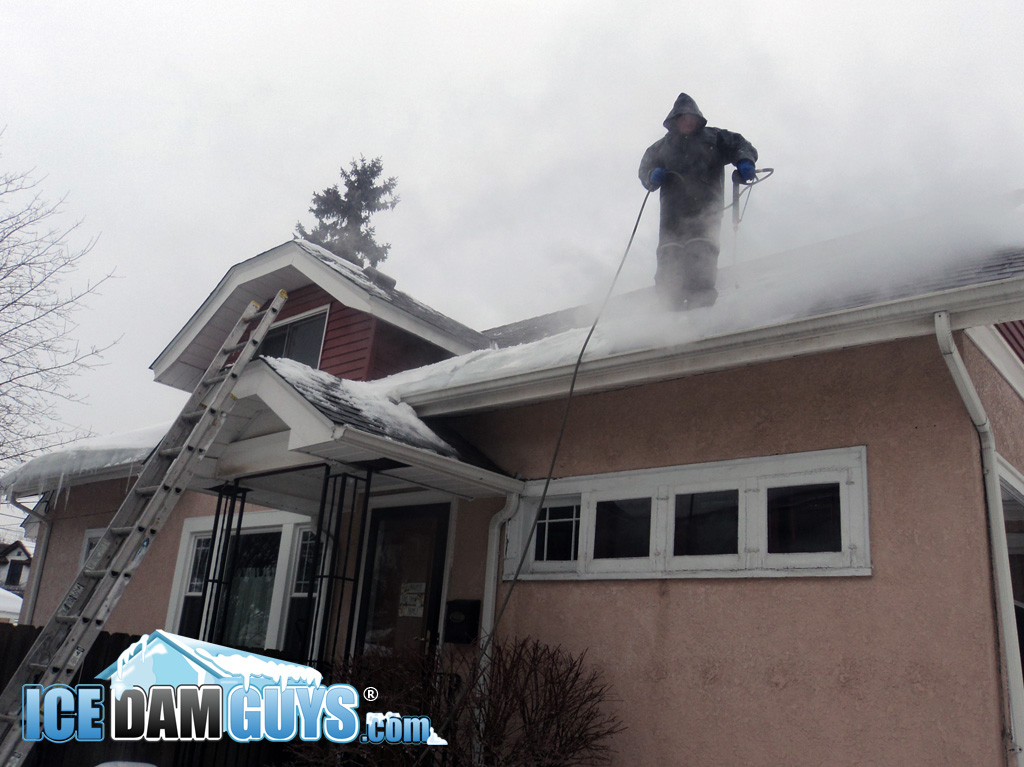
Steam is the only safe and effective way to remove an ice dam. It won’t damage your roof and it won’t make leaks worse.
Theoretically, if you have $3000 – $5000 to burn, you could buy a steamer online from some hardware stores. However, you can’t buy the training to use the steamer to remove an ice dam, and it takes training to do the job correctly. You can’t buy any insurance policy that will protect you if you decide to jump on the roof with one.
Besides, you might need more than one. We carry redundant ice dam steamers into battle with us. They freeze up more often than you think they do. If you’re not experienced, you could actually destroy them. At that point, you haven’t saved a dime by trying to be the intrepid hero who is doing it all himself.
And, again, why would you put your life at risk? We’ve lost people in this industry. It’s dangerous. The roof is slippery. There’s not a lot of effective safety equipment out there that can make it less slippery. Chunks of ice start sliding around as you’re working. Things can and do go wrong.
So if an ice dam has formed in spite of your best efforts, reach for the only tool you ought to be touching: the phone. Call qualified ice dam removal specialists as early as you can so that they can take care of you, your family, and your home.













